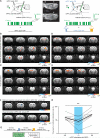Prefrontal cortical regulation of brainwide circuit dynamics and reward-related behavior
- PMID: 26722001
- PMCID: PMC4772156
- DOI: 10.1126/science.aac9698
Prefrontal cortical regulation of brainwide circuit dynamics and reward-related behavior
Abstract
Motivation for reward drives adaptive behaviors, whereas impairment of reward perception and experience (anhedonia) can contribute to psychiatric diseases, including depression and schizophrenia. We sought to test the hypothesis that the medial prefrontal cortex (mPFC) controls interactions among specific subcortical regions that govern hedonic responses. By using optogenetic functional magnetic resonance imaging to locally manipulate but globally visualize neural activity in rats, we found that dopamine neuron stimulation drives striatal activity, whereas locally increased mPFC excitability reduces this striatal response and inhibits the behavioral drive for dopaminergic stimulation. This chronic mPFC overactivity also stably suppresses natural reward-motivated behaviors and induces specific new brainwide functional interactions, which predict the degree of anhedonia in individuals. These findings describe a mechanism by which mPFC modulates expression of reward-seeking behavior, by regulating the dynamical interactions between specific distant subcortical regions.
Copyright © 2016, American Association for the Advancement of Science.
Figures






Comment in
-
NEUROSCIENCE. Illuminating anhedonia.Science. 2016 Jan 1;351(6268):24-5. doi: 10.1126/science.aad9698. Science. 2016. PMID: 26721987 No abstract available.
References
-
- Schultz W. Predictive reward signal of dopamine neurons. J. Neurophysiol. 1998;80:1–27. pmid: 9658025. - PubMed
-
- Fiorillo CD, Tobler PN, Schultz W. Discrete coding of reward probability and uncertainty by dopamine neurons. Science. 2003;299:1898–1902. doi: 10.1126/science.1077349; pmid: 12649484. - PubMed
Publication types
MeSH terms
Substances
Grants and funding
LinkOut - more resources
Full Text Sources
Other Literature Sources
Medical

